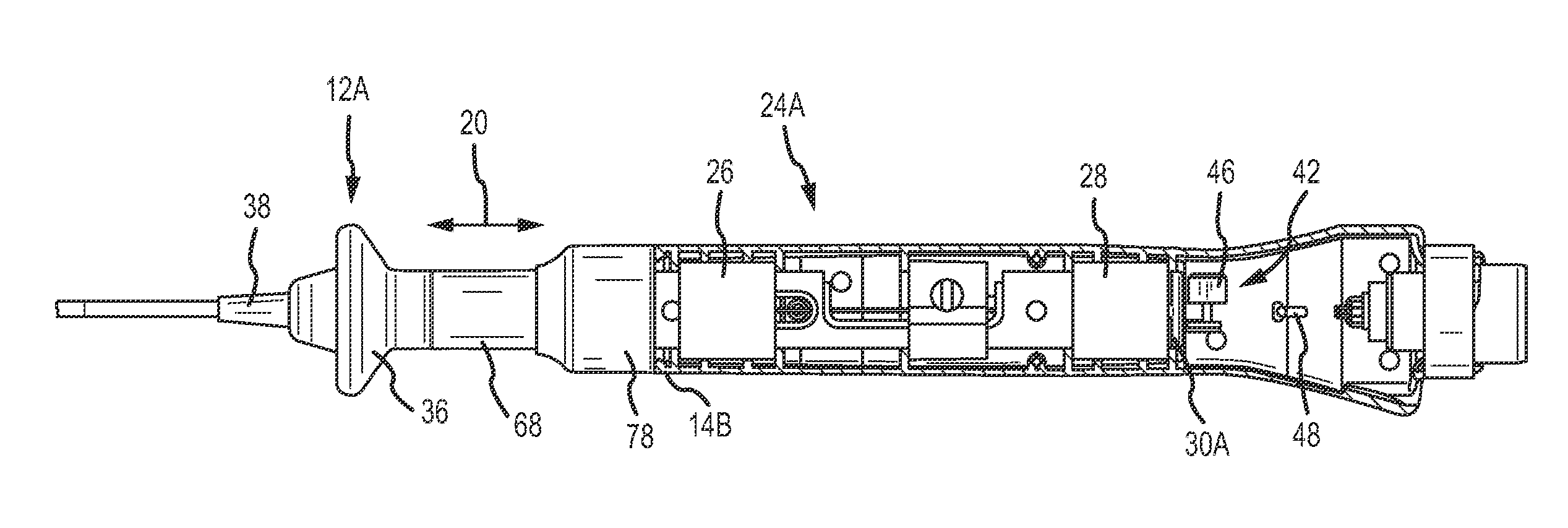Catheter having an active return-to-straight mechanism
a catheter and straight mechanism technology, applied in the field of actuators, can solve the problems of limiting, corralling, or otherwise preventing, and a wide range of symptomatic and asymptomatic ailments
- Summary
- Abstract
- Description
- Claims
- Application Information
AI Technical Summary
Benefits of technology
Problems solved by technology
Method used
Image
Examples
first embodiment
[0070]FIG. 22 is an exploded, isometric view of a catheter handle 24A having the active return-to-straight mechanism 42 and also shown to good advantage in FIGS. 12, 14, 16, 19, and 21. As shown in FIG. 22, the actuator includes a lower handle housing 60 and an upper handle housing 62 having a number of components sandwiched between them. As shown in the central portion of this figure, a plunger assembly is slidably mounted in two sleeve bearings 26, 28. At a proximal end of the plunger, a plunger cap 30A is present. The lever 46 comprising part of the active return-to-straight mechanism 42 is pivotably mounted to the proximal side of the plunger cap 30A. A lever tuner 64 is shown in FIG. 22. In the assembled mechanism, this tuner is threaded into the tuner drum 54 (see FIG. 29) of the lever to attach the otherwise inactive deflection element 56 to the lever 46.
[0071]As also shown in FIG. 22, at the distal end of the plunger 12A, a shaft lug 66 and a strain relief 38 are present, a...
third embodiment
[0076]FIGS. 33-43 depict an active return-to-straight mechanism 42B according to a In particular, FIGS. 33-36 depict the catheter 10B and various enlarged portions of the catheter while the catheter is in a fully-actuated configuration, placing the catheter tip portion 16A in a fully-deflected configuration. FIGS. 37-39 depict the catheter 10B, and enlarged portions of the catheter, when the plunger assembly 12B is in a semi-neutral position (i.e., a nearly fully-retracted configuration). Finally, FIGS. 40-43 depict the catheter 10B and various enlarged components of the catheter, when the plunger assembly 12B has been fully retracted to a neutral position (i.e., when the plunger assembly has been fully retracted into a handle housing 14C), thereby actuating the active return-to-straight mechanism 42B.
[0077]As shown to best advantage in FIGS. 34, 36, 38, 41, and 43, in this configuration, the active return-to-straight mechanism 42B includes a lever 46B that is pivotably mounted to ...
fourth embodiment
[0081]FIG. 44 depicts a fourth embodiment for actively returning the distal deflectable portion of a catheter shaft 18A to a substantially straight configuration through interaction with a single user actuator 116. In particular, FIG. 44 shows a plunger-type actuator 12C and a fragment of a catheter shaft 18A. In FIG. 44, a pull wire 56B (other than the pull wire used to deflect the distal deflectable section of the catheter shaft) is shown in solid lines extending around a wire lateral deflection pin 100 to a wire anchor 102. In this configuration, the lateral deflection pin 100 and the wire anchor 102 are located on opposite sides of the catheter longitudinal axis 40A, and the wire anchor is located proximal to the lateral defection pin. A wire longitudinal deflection pin 104 is also shown in solid lines. This wire longitudinal deflection pin is mounted to the handle housing, whereas the lateral wire deflection pin 100 moves with the plunger assembly 12C.
[0082]Still referring to F...
PUM
 Login to View More
Login to View More Abstract
Description
Claims
Application Information
 Login to View More
Login to View More - R&D
- Intellectual Property
- Life Sciences
- Materials
- Tech Scout
- Unparalleled Data Quality
- Higher Quality Content
- 60% Fewer Hallucinations
Browse by: Latest US Patents, China's latest patents, Technical Efficacy Thesaurus, Application Domain, Technology Topic, Popular Technical Reports.
© 2025 PatSnap. All rights reserved.Legal|Privacy policy|Modern Slavery Act Transparency Statement|Sitemap|About US| Contact US: help@patsnap.com



